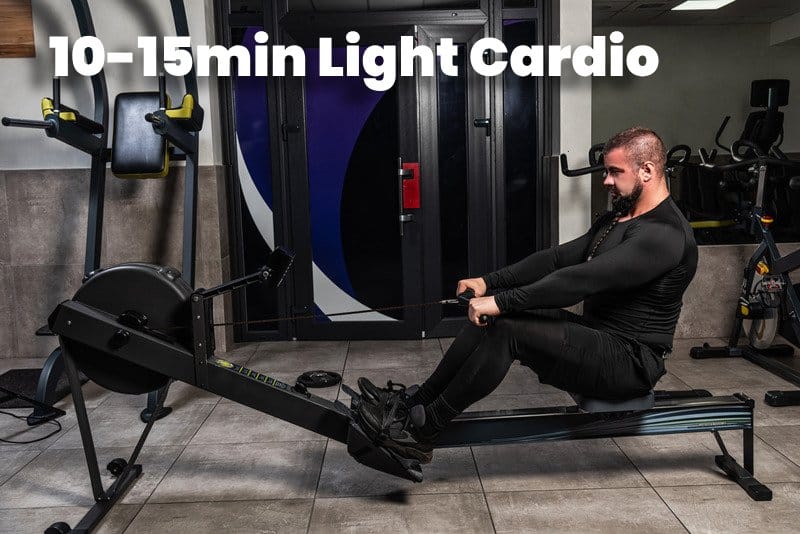Ever felt that annoying twinge in your shoulder during a bench press? You’re not alone. It turns out, a solid warm-up routine can be your best defense against these common gym annoyances.
Today I’ll walk you through some easy yet super effective warm-up exercises.
These aren’t just any stretches and lifts; they’re specifically designed to get your blood flowing, muscles loose, and joints ready for action. Perfect for making your bench press sessions safer and more effective.
So, if you’re keen on ditching those shoulder pains and leveling up your lifting game, stick around and give this a read!
Jump to:
Importance of Warm-Up – Increase Body Temperature

Benefits of Warming Up
Warming up before performing bench press exercises is crucial for maximizing your workout efficiency. A proper warm-up increases blood flow, body temperature, and heart rate to prepare your body for the exercise. This leads to an overall improved performance.
When you warm up, your muscles become more oxygenated and flexible, which allows for better strength and power output during the bench press. One study in the Journal of Strength and Conditioning Research observed that a combination of general and specific warm-up exercises led to improved performance in resistance training exercises like the bench press.
Injury Prevention
Injury prevention is another key reason to incorporate warm-ups before your bench press workout. By elevating your body temperature and promoting blood flow to the muscles, you decrease the risk of muscle strains and tears.
In addition, warming up helps lubricate the joints, allowing for smoother movements and reducing joint stress during the bench press exercise. A study published in Sports Medicine reported enhanced force production and reduced injury risks with proper warm-up strategies in sports and exercise.
So, before any lifting session, you should start with 10-15 minutes of light cardio (rower, bike running, pick your poison).
Preparatory Stretches
Before diving into your bench press routine, it’s important to properly warm up your upper body. This helps increase flexibility, decrease the risk of injury, and improve your overall lifting performance.
1- Shoulder Mobility Stretches
Your rotator cuff plays a crucial role during the bench press movement. Therefore, incorporating shoulder mobility stretches in your warm-up routine is essential to promote better range of motion as well as alleviate stress on the rotator cuff muscles. Here are a few recommended mobility exercises:
- Arm Circles: Perform slow, deliberate circles with your arms, both clockwise and counterclockwise. Gradually increase the size of the circles as your shoulders warm up.
- Cross-Body Shoulder Stretch: Gently pull one arm across your chest horizontally and hold it with your opposite hand. Hold the stretch for 15-20 seconds, then switch arms.
- Doorway Stretch: Stand in a doorway and place your hands on the door frame at shoulder height. Lean forward into the stretch, opening up your chest and shoulders. Hold for 15-20 seconds.
Upper Back and Chest Openers
The upper back and chest muscles are heavily engaged during the bench press as well. It’s important to warm up these areas to improve your pressing movement and reduce the risk of strains or imbalances. Try incorporating these upper back and chest opener stretches into your warm-up:
- Cat-Cow Stretch: Start on your hands and knees. Inhale and drop your belly towards the ground as you lift your chin and chest upwards (cow position). Exhale and round your spine, tucking your chin towards your chest (cat position). Repeat for a total of 10 cycles.
- Thoracic Extension: Sit on your knees with your feet together. Place your hands behind your head and lean back, extending your upper back as you maintain a neutral lower spine. Hold for a breath, then return to the starting position. Repeat for a total of 10 repetitions.
- Foam Roller Chest Stretch: Lay on your back with a foam roller placed vertically along your spine. Extend your arms out to the sides in a “T” shape with palms facing up. Allow your chest to open and feel the stretch along your pectoral muscles. Hold for 30-60 seconds.
Foam Rolling Techniques
To properly use a foam roller, follow these steps:
- Position the foam roller under the targeted muscle group, such as your chest or upper back.
- Use your body weight to apply pressure on the roller, and slowly roll back and forth across the muscle group for 30 seconds to 1 minute.
- Gradually increase the pressure as needed, ensuring to focus on any tight or sore areas.
A specific technique you can try for your chest is the pec minor release. Here’s how to do it:
- Lie face down with the foam roller positioned diagonally across your chest.
- With your arm extended out to the side, slowly roll the foam roller in small movements, targeting the pec minor muscle.
- For added effectiveness, pause on tight spots and allow the pressure to release the tension.
Remember to release and improve neuromuscular performance by applying foam rolling techniques at ten-minute intervals during your warm-up.
Resistance Band Exercises

Resistance band exercises can aid in activating and strengthening the muscles used in the bench press. Two effective exercises to include in your warm-up are band pull-aparts and shoulder dislocations.
Band Pull-aparts: This exercise targets the muscles in your upper back, promoting scapular retraction and shoulder stability.
- Hold a resistance band with both hands, arms extended in front of your chest.
- Keep your arms straight and pull the band apart, squeezing your shoulder blades together.
- Slowly return to the starting position and repeat for 10-15 reps.
Shoulder Dislocations: This exercise helps develop shoulder mobility and flexibility, which is crucial for a proper bench press form.
- Hold a resistance band with both hands, arms extended overhead.
- Keep your arms straight and slowly bring the band down behind your head, lower back, and hips.
- Reverse the movement to return to the starting position and repeat for 10-15 reps.
Activation Drills
Muscle Activation Techniques
Muscle activation techniques (MAT) are essential for preparing your body for a bench press workout. The primary goal of these exercises is to improve the mind-muscle connection and activate your nervous system, which helps in maximizing performance during your workout. Some common activation techniques include self-myofascial release (SMR) and dynamic stretching.
For example, when warming up for bench press, using a foam roller on your chest, shoulders, and upper back can help release muscle tightness and improve blood flow. Likewise, dynamic stretches like arm circles and arm swings can further increase flexibility and prepare the muscles for the upcoming workout. Remember to perform these exercises in a controlled manner, focusing on the mind-muscle connection throughout the movements.
Shoulder and Arm Activation

Properly activating your shoulders and arms is vital for a safe and effective bench press workout. Dumbbell warm-up exercises are an efficient way to engage these muscle groups and improve joint stability. Here are a few exercises you can incorporate into your warm-up routine:
- Dumbbell Shoulder Press: Perform 2 sets of 10-12 reps with light weights, focusing on a controlled movement and full range of motion. This exercise activates your deltoids and helps improve shoulder stability.
- Side Lateral Raise: Execute 2 sets of 10-12 reps with lightweights to target the medial head of your deltoids, enhancing shoulder mobility and stability.
- Bent Over Reverse Fly: Complete 2 sets of 10-12 reps with lightweights, emphasizing the rear deltoids and upper back muscles. This exercise helps improve scapular retraction and stability during the bench press.
Additionally, consider incorporating high-intensity warm-up sets with a lighter load on the bench press to further prepare your arms and shoulders for the upcoming workout.
Stabilization Exercises
Besides dynamic movements, focusing on stabilization exercises can help to strengthen key muscles in your upper body. This will ensure you have a stable base when benching big weights.
One stabilization exercise you can perform is the plank. Planks engage your core, shoulders, and back muscles, providing a strong base for your bench press. It’s crucial to strengthen these muscles, as they help stabilize your upper body when lifting heavy weights.
Another exercise to include in your warm-up is the face pull. Face pulls primarily target the upper back and rear shoulder muscles, helping to stabilize your shoulders and maintain proper form during the bench press.
Remember to keep these exercises light and focused on the stability and mobility aspect, as you don’t want to exhaust your muscles before your main workout.
In summary, here are some stabilization exercises to add to your warm-up:
- Plank
- Face pull
Including both dynamic movements and stabilization exercises in your warm-up routine will help to mobilize and stabilize the key muscles needed for the bench press. Make sure to incorporate these exercises as part of a well-rounded warm-up to maximize your bench press performance.
Progression Into Weightlifting
From Light to Working Sets
Proceed to the bench press by performing a set with just the bar. This initial set helps you practice your form and prepares the muscles for heavier weight. Then, your next warm-up set can be around 50% of your working weight for 8-10 reps.
Gradually increase the load in small increments, called ramping up, to avoid fatigue but still fully activating your muscles for the coming exercise.
For instance, if you’re aiming for a working weight of 200 pounds, you can follow these steps:
- Warm-up set 1: bar only, 10-15 reps
- Warm-up set 2: 50% working weight (100 lbs), 8-10 reps
- Warm-up set 3: 70% working weight (140 lbs), 5-6 reps
- Working sets: 100% working weight (200 lbs), per your desired reps and sets
Ramping Up Intensity
A study on the effects of specific warm-up in the bench press recommends a progressive-intensity warm-up involving two sets of 6 repetitions with 40% and 80% of your training load. This approach has been found to be the most effective at reducing the time it takes to reach peak performance during your working sets.
In order to ramp up intensity effectively, it’s important to pay attention to your body’s feedback. You should increase the weight according to your comfort level and perceived exertion, while still maintaining good form. The goal is to reach your working weight without feeling exhausted or risking injury.
Once you feel ready, you can start your actual routine.
Last Words – Personalizing Your Warm-Up
Adjusting to Individual Needs
When planning your warm-up before a bench press session, it’s essential to consider your individual needs. Your warm-up routine should be tailored to your unique physical structure, fitness level, and personal best. Start by including a combination of stretching, mobility exercises, and low-intensity resistance movements that prepare your muscles and joints for the main workout.
To pay heed to potential injuries, consult a physical therapist or a qualified professional who can help you design a warm-up routine that addresses your specific concerns. Incorporating their feedback into your warm-up will minimize injury risks and facilitate your progress.
If you have past or pre-existing injuries, you should prioritize:
- Targeted stretches for affected muscles and joints
- Specialized mobility exercises recommended by your therapist
- Gradual progression in intensity
Consulting with Coaches and Therapists
Collaborating with coaches and therapists is invaluable for personalizing your warm-up. Their expertise allows them to identify your strengths and weaknesses, address specific issues, and optimize your workout plan. A well-informed bench press warm-up may include the following:
- 5-minute dynamic stretching session targeting the upper body
- Rotator cuff mobility exercises for shoulder health
- 2-3 sets of light bench press with increased reps for muscle activation
- Additional injury-prevention exercises based on individual requirements
By assessing your physical condition and personal best, an experienced coach can help fine-tune your warm-up routine. Engaging with professionals also equips you with valuable knowledge that enhances your overall gym experience, making your bench press warm-up more effective and safe.














